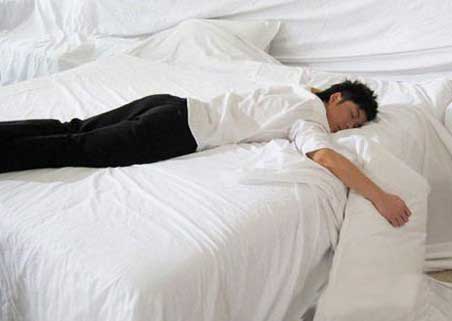This post may contain affiliate links for mentioned products. If you click a link and buy something, as an Amazon Associate I earn from qualifying purchases.
 Which type of bed is better, soft or firm? As a matter of fact, the one that fits you is the better. In the mattress store, you reach hands to neck, waist, area between buttocks and legs and feel if there are gaps in these areas. If you don’t feel gaps on a mattress, that’s the mattress fitting you perfectly and take it home.
Which type of bed is better, soft or firm? As a matter of fact, the one that fits you is the better. In the mattress store, you reach hands to neck, waist, area between buttocks and legs and feel if there are gaps in these areas. If you don’t feel gaps on a mattress, that’s the mattress fitting you perfectly and take it home.
Soft bed is more comfortable for many people and gives us a feeling of safety. Some people find they sleep sound on the soft bed. The whole body tends to sink into the bed. Getting up from soft bed is more difficult than on the firm bed. Therefore, soft bed isn’t recommended to old people suffering from weak bones. It doesn’t relax vertebrae but make ligaments around vertebrae overburdened. That’s also why people who have prolapse of lumbar intervertebral disc should avoid the soft bed. 80% of people suffering from a slipped disc got better after they received treatment and slept on the firm bed. The hard bed can prevent the spine curve so it well suited for humpbacked teenagers. But for ordinary people, hard mattress may cause pressure and tension. They will toss and turn too much at night and can’t get enough sleep. It’s not suitable for people who work hard, have sleep disorders and pursue high sleep quality.
A good bed should be neither too hard nor too soft, supportive, highly breathable and made of green material. Generally speaking, 10 cm thick would be appropriate for a spring mattress, which is the right thickness for body curve to keep spine straight and normal curvature. You must test drive before buying one. Fall down to the bed and thrash about. Stretch out on the bed and reach to neck, waist and areas between legs and buttocks to check if any gaps exist. When sleep on your side, check if there are gaps between these areas and mattress. If not and your spine is still in the straight line, that indicates that the mattress conforms to your shape and is able to offer support your whole body need.
The appropriate length of a mattress should be 20 inches more than your height. It allows enough space for stretching out and pillows, and reduces pressure and tension when you sleep. Turn upside down once every three or four months to make both side of mattress bear pressure evenly and extend lifespan.
Nowadays, people have formed a good habit and they wash and air sheets, pillowcase and quilt. But pillow stuffs in the cases are usually ignored by us. When you are sleeping, sebum, sweat and saliva diffuse into pillow stuffs. If you don’t wash and clean it, bacterium will root deep in it and become seeds of disease.

